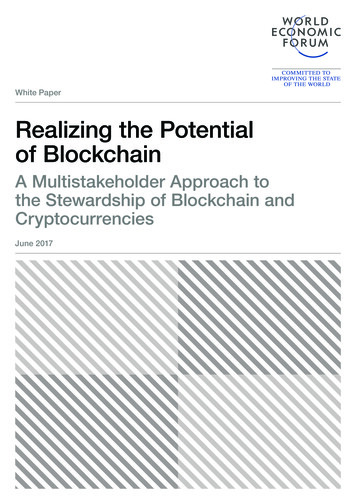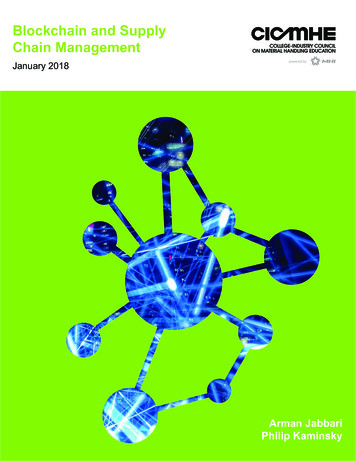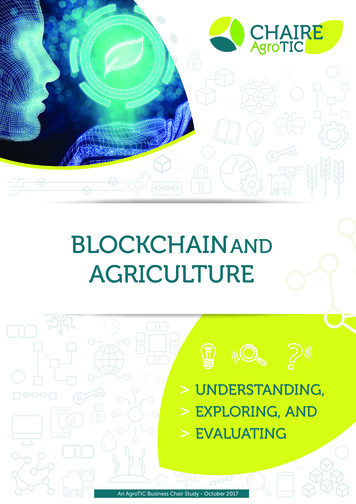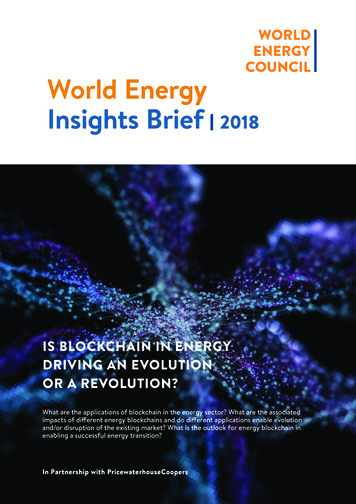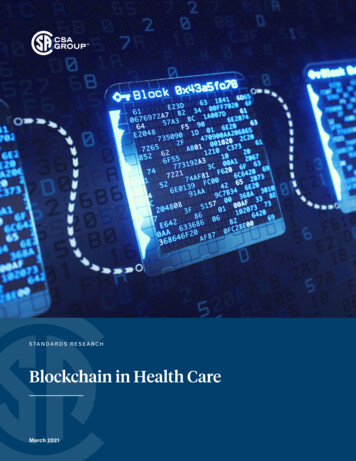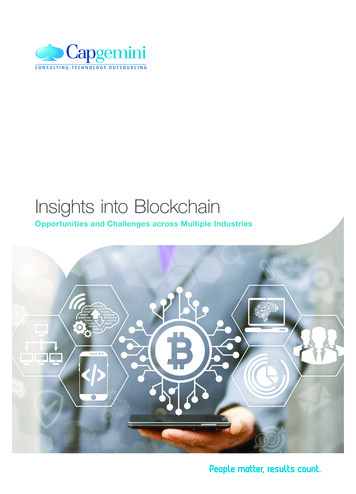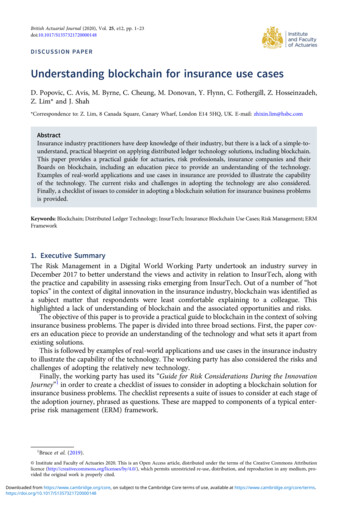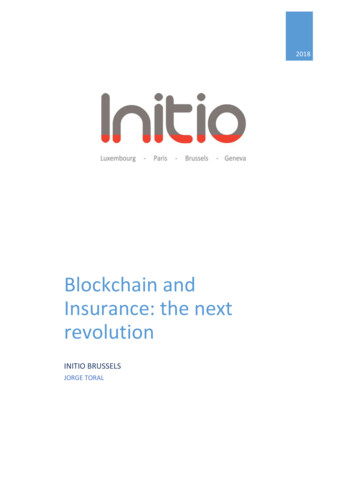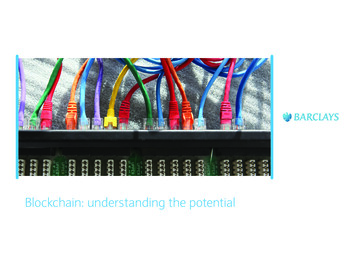
Transcription
Blockchain: understanding the potential
Blockchain: understanding the potentialBitcoin, heralded by many as the single biggest breakthrough since the arrival of the internet, has proved to besomething of a moving target since its launch in 2009. However, it continues to be the focus of significantinvestment and innovation with the industry predicting that more than 1 billion in venture capital funding willhave been invested in bitcoin and its future by the end of 2015*Recent developments include BitPesa, a Nairobi-clichés and misconceptions have grown up aroundThis may prove to be the case – but rather thanbased start-up focusing on bitcoin remittances,the digital currency and its underlying technology.simply leaving it there, banks and companies couldwhich raised over 1 million earlier this year andThese misconceptions can hinder discussions aboutbe delving into this topic to understand what makesEarthport which agreed a partnership with Ripplethe future direction of development and the way inthis technology so attractive and what types ofLabs allowing real-time cross-border bank paymentswhich initiatives are presented in the media.application could be created. It is only when theBut, it is becoming increasingly clear that bitcoin isFor one thing, its associations with Silk Road, thepart of an even bigger story: financial institutions,digital black market, have left some people withincluding Barclays, are now considering howthe assumption that bitcoin is linked to moneythe technology underpinning digital currency –laundering and terrorists. Education is improving oncommonly called ‘the blockchain’ or ‘blockchain’this point, but misconceptions continue to affect the– could in itself revolutionise finance. While many ofway that many people think about bitcoin.these potential applications are medium term thedevelopment cycles in the industry mean that nowis the time for companies to begin asking how thistechnology could benefit them.Challenging the misconceptionsBitcoin may have attracted significant attentionaround the world – but alongside all the hype, many*Blockchain technology is likewise subject to certainclichés. In the first instance, attention focusedclosely on bitcoin itself and how the digital currencywas going to change the world. In the last coupleof years, this focus has shifted and many peopleare now repeating the assertion that blockchaintechnologies are more interesting than Bitcointhe re-capital-funding-pace-1-billion-2015/306652 of 5possibilities are explored in more detail that the truescale of possible change can be appreciated.
Understanding blockchainIn recent years, there have been many differentprocesses which are genuinely different, because ofinitiatives intended to remove paper from thethe way many of these technologies work. The trickThe first port of call should be to gain aneconomy. However, in many cases the newis in something called “consensus”. Like consensusunderstanding what makes this technology so special.technology has simply recreated old processes inin a room full of people, computers use algorithms toBlockchain technology, which underpins bitcoin, has aa new way, or has led to solutions which continue toreach consensus about the truth. This contrasts withnumber of interesting attributes. There are two mainrely on paper. For example, the process of signing atoday, where every bank, government departmenttypes of Blockchain Technologycheque was digitised by creating a cheque guaranteeand law firm has their own paper copy of the truth. Ifcard, followed by a PIN card – but the new modelwe could rely on maths to “sync” the truth betweencontinues to work on the same hub and spokesus all, we coud cut out a lot of wasted back and forthmodel that the previous cheque system had used.paper from the likes of:1. Unpermissioned2. Permissioned (sometimes ‘distributed ledgers’or ‘replicated shared ledger’)An Unpermissioned blockchain is an open,decentralised ledger which records the transfer ofvalue. Every transaction is cryptographically chainedto the previous transaction. The result isIn other cases, such as tenancy agreements, thereis a continuing need for a piece of paper that will Trade Financehold up in court. Land RegistryA Permissioned blockchain technology could, in Social Welfarecontrast, replace certain paper-based processes witha permanent, immutable and verifiable record of Insurance KYC and AMLtruth that everyone can see. This is useful whenno central entity is available to verify a transaction.To name just a few.Unpermissioned Blockchains are “censorshipresistant”. Nobody can edit them, meaning if youBlockchain and distributedledgers businesswant to record a statement of fact with your nameon it (for example; “Alice would like to pay Bob 1” or“This is my last will and testament”), UnpermisionedAs outlined above, whilst Bitcoin had a numberblockchains are a great place to do thisof breakthroughs such as the creation of a widelyavailable and very difficult to attack permanentA Permissioned blockchain technology is often farand censorship resistant database. Some of thesemore appealing to enterprise and financial services.characteristics could also make this technologyTo understand this we need to explore one of theparticularly relevant to a number ofbiggest problems with financial services and industry;financial processes.the cost of paper.3 of 5
From regulatory reporting to derivatives settlement,the various blockchain technologies could be usedto transform the many key services industry sectors,reducing cost, increasing the speed and transparencyfor data and reducing reliance on paper.Putting it all togetherOne interesting development is Everledger,a permanent ledger for the certification andtransaction history of diamonds. In the past, differentstages of a diamond’s value chain have tended toSMART CONTRACTS “When paper knowswhat you told it to do”be disparate and paper-based: the producer of theImagine a contract that you sign, where all of thewhich can be lost or forged at any point.key clauses could automatically execute. This isthe promise of a “Smart Contract”. If we assumethe blockchain technology of choice is helping keeprecords in sync between multiple parties (e.g. whichshipping container is which television in), then SmartContracts are the logic layer on top that allow for “ifthis, then do that” conditions to be actioned directlydiamond, the shipping and the insurance would allhave been recorded using pieces of paper – all ofToday, these different strands can be broughttogether. Drawing upon blockchain technology,Everledger provides an immutable record of theownership of diamonds which allows individualjewels to be identified and tracked using a commondatabase. The diamond’s serial number is registeredfrom the agreement.against the database (or ‘blockchain’) and usersTaking our television example further. What if theagencies can access the entire history of a specificcurrent buyer had agreed they would buy 100xdiamond, including details such as changes oftelevisions from the seller so long as the market priceownership and insurance details. If a diamond isfor televisions stayed above 1? A smart contractstolen and recovered on the other side of the world,would record this “clause” in the same way a paperthis database can allow the police to determinecontract would. The difference however is if thequickly the history of the item and itsprice of a television fell below 1, the smart contractinsurance details. Everledger is live today withcould change the owner of the television back toover 800,000 diamonds being tracked on theirthe seller.blockchain technology.such as insurance companies or law enforcementOther items may also benefit from this type of audittrail. With greater attention paid to the origins ofitems such as organic and fair trade produce, ablockchain could certify the history of specific items,including the origins of the food, whether the farmwas certified (e.g. by the Soil Association) and theamount paid to the farmer.Corporates may wish to consider how SmartContracts may change their business.4 of 5
Overcoming the obstaclesThe key gap is education, we often conflate “TheBlockchain” and “A Blockchain”. This terminology isespecially tricky because the technology is so new,come into being. It’s also clear that the security andIn conclusion, Bitcoin was a significant breakthroughcontrols associated with blockchain technology will– but it’s not the whole story. The technologiesneed development before many of these applicationsaround bitcoin have the potential to transformcan become mainstreammany different processes and companies should beterms are emerging daily to try and understand andThat said, the opportunities are so significant thatmake sense of it.it’s a question of when, not if, these applicationsThis is a nascent technology and while theopportunities are exciting, certain obstacles will needto be overcome before some of these use cases canwill emerge. In order to smooth the way fordiscussing these developments at the board leveland asking how this technology could help them andwhether they should be investing in it.greater development and adoption, financialservice providers and start-ups will need tocollaborate closely.About the authorSimon TaylorBlockchain and Distributed Ledger Subject Matter ExpertNamed by City AM as one of the Top 10 most influential people in Fintech, Simon’s workat Barclays focuses on understanding the impact of this new technology on Barclaysbusinesses and clientsbarclays.com/corporatebankingBarclays is a trading name of Barclays Bank PLC and its subsidiaries. Barclays Bank PLC is authorised by the Prudential Regulation Authority and regulated by the Financial Conduct Authorityand the Prudential Regulation Authority (Financial Services Register No. 122702). Registered in England. Registered number is 1026167 with registered office at 1 Churchill Place, London E14 5HP.Item Ref: BM408383. July 2015.5 of 5
Understanding blockchain The first port of call should be to gain an understanding what makes this technology so special. Blockchain technology, which underpins bitcoin, has a number of interesting attributes. There are two main types of Blockchain Technology 1. Unperm
